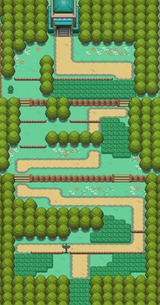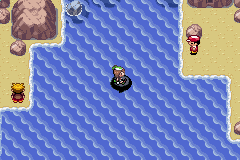Route: Difference between revisions
m (Robot: Automated text replacement (-^\[\[es:[^]]*\]\]\n +, -^\[\[pt:[^]]*\]\]\n +)) |
m (unofficial translation) |
||
| (5 intermediate revisions by 5 users not shown) | |||
| Line 12: | Line 12: | ||
===Numbered route=== | ===Numbered route=== | ||
{{main|List of routes}} | {{main|List of routes}} | ||
Up to [[Generation | Up to [[Generation VI]], there are 157 numbered routes in the Pokémon world, all identified simply as ''Route'' followed by their number. The route numbers in [[Kanto]], [[Johto]], [[Hoenn]], and [[Sinnoh]] avoid overlapping with each other, but the route numbers in [[Unova]] and [[Kalos]] forego this consideration. | ||
Hoenn and Sinnoh's | Kanto and Johto contain 48 consecutively numbered routes, with {{rtn|1|Kanto}} through {{rtn|28|Kanto}} in Kanto (only through {{rtn|25|Kanto}} in [[Generation]]s {{gen|I}} and {{gen|III}}) and {{rtn|29|Johto}} through {{rtn|48|Johto}} in Johto (only through {{rtn|46|Johto}} in [[Generation II]]). Hoenn and Sinnoh's route numbers are not consecutive with Kanto and Johto's or with each other, possibly due to the fact that these [[region]]s are not directly connected. Hoenn contains routes numbered {{rtn|101|Hoenn}} through {{rtn|134|Hoenn}}, while Sinnoh contains routes numbered {{rtn|201|Sinnoh}} through {{rtn|230|Sinnoh}}. | ||
After Generation IV, the new regions ceased attempting to avoid overlapping route numbers with the old ones. This may imply that Unova and Kalos are distant from the other regions and each other, and therefore uninfluenced by their routes. Unova contains routes numbered {{rtn|1|Unova}} through {{rtn|23|Unova}}, while Kalos contains routes numbered {{rtn|1|Kalos}} through {{rtn|22|Kalos}}. | |||
The numbering of the routes in the Pokémon world may | The numbering of the routes in the Pokémon world may be a reference to Japan's own national route system, which goes from {{wp|Japan National Route 1|1}} to {{wp|Japan National Route 58|58}}, then skips directly to {{wp|Japan National Route 101|101}}, and afterwards skips several numbers. Despite this, the routes do not run concurrent with their Pokémon counterparts, and indeed in Japan there exists a {{wp|Japan National Route 135|Route 135}}, a {{wp|Japan National Route 231|Route 231}}, and so on, up to {{wp|Japan National Route 507|Route 507}}. Strangely, the only numbers skipped are routes whose numbers are used in [[Hoenn]] and [[Sinnoh]]. | ||
===Named route=== | ===Named route=== | ||
| Line 42: | Line 42: | ||
==See also== | ==See also== | ||
* [[List of routes]] for a list of all numbered and named routes | * [[List of routes]] for a list of all numbered and named routes | ||
==In other languages== | ==In other languages== | ||
{{langtable | {{langtable | ||
| Line 54: | Line 55: | ||
|pt=Rota | |pt=Rota | ||
}} | }} | ||
{{-}} | {{-}} | ||
{{Project Routes notice}} | {{Project Routes notice}} | ||
[[Category:Routes]] | [[Category:Routes]] | ||
[[de:Route]] | [[de:Route]] | ||
Revision as of 10:41, 3 June 2016

A route (Japanese: 道路 route) in the Pokémon world is a passage permitting Trainers and others to travel between locations with relative ease. Usually what defines a route is a location between two or more cities, however many passageways between cities are too long, thus, this passageway can be broken down into several routes, each joining onto another route at its terminal. Routes are depicted as a long, narrow, and sometimes winding roads, riddled with obstacles such as rocks, trees and even ledges blocking the pathway. Although routes are a barricaded area, they are difficult to maneuver around and are a maze of winding paths that Trainers strive to explore. Routes in the Pokémon games, unlike the Pokémon anime, are formed as a straight path with two or more termini and depicted as a bordered off, barricaded area. Land routes are usually surrounded by trees so thick that even Trainers cannot penetrate them, causing them to act as a barrier to stop players from venturing further.
Most routes are associated with tall grass in which wild Pokémon, including Roaming Pokémon, can be found. If the player enters a patch of tall grass, they may randomly enter a wild Pokémon battle. Tall grass is found on most routes of the Pokémon world, with some routes containing more tall grass patches than others. People are generally warned to stay out of tall grass if they don't have a Pokémon due to the possibility of being attacked by wild Pokémon. Some areas in the Pokémon world have larger patches of grass than usual. These patches of grass have grown longer and more widespread than the usual grass patches, hiding many different species of Pokémon. Because of the length and thickness of the grass, it is impossible to ride a bicycle or run through the patches in Generation III.
Pokémon Trainers localize themselves in routes to train their Pokémon. They do this normally by battling the wild Pokémon that live in the tall grass, however, many Trainer wish to gain experience further by challenging other Trainers to a battle, and no matter what their specialties or aims, there is one code that they all follow: when two Trainers make eye contact, they must have a battle. However, not all people travelling through a route wish to have a battle, many just want to get to another town or city easily, and therefore will sometimes help other Trainers with friendly advice. Trainers also carelessly drop items on the ground while passing by a route, and so another Trainer is able to come by and take it. Although, these ground items can be obtained through natural means, items are very often found by Trainers throughout every route. These ground items are called 'Item Balls' because they are spherical containers resembling a small Poké Ball. However, finding items on the ground is not always as easy as seeing it and picking it up. Many items are hidden from view, and can only be obtained by a very lucky chance or, more commonly, through the use of an item finding tool.
Although each region has its own set of numbered routes, there are numerous other passages throughout the Pokémon world, all of which are named, that can be considered routes as well.
Systematization of routes
Numbered route
- Main article: List of routes
Up to Generation VI, there are 157 numbered routes in the Pokémon world, all identified simply as Route followed by their number. The route numbers in Kanto, Johto, Hoenn, and Sinnoh avoid overlapping with each other, but the route numbers in Unova and Kalos forego this consideration.
Kanto and Johto contain 48 consecutively numbered routes, with 1 through 28 in Kanto (only through 25 in Generations I and III) and 29 through 48 in Johto (only through 46 in Generation II). Hoenn and Sinnoh's route numbers are not consecutive with Kanto and Johto's or with each other, possibly due to the fact that these regions are not directly connected. Hoenn contains routes numbered 101 through 134, while Sinnoh contains routes numbered 201 through 230.
After Generation IV, the new regions ceased attempting to avoid overlapping route numbers with the old ones. This may imply that Unova and Kalos are distant from the other regions and each other, and therefore uninfluenced by their routes. Unova contains routes numbered 1 through 23, while Kalos contains routes numbered 1 through 22.
The numbering of the routes in the Pokémon world may be a reference to Japan's own national route system, which goes from 1 to 58, then skips directly to 101, and afterwards skips several numbers. Despite this, the routes do not run concurrent with their Pokémon counterparts, and indeed in Japan there exists a Route 135, a Route 231, and so on, up to Route 507. Strangely, the only numbers skipped are routes whose numbers are used in Hoenn and Sinnoh.
Named route
Not every route is known by a number. Some routes have a unique, descriptive name, such as the seventeen named paths and the small cave between the main cities and major landmarks of the Sevii Islands.
Types of routes
Terrain routes

Terrain routes are located on land and are the first most Trainers come across. These routes can come in the form of forests, deserts, plains, mountainous, swamps, beaches or just grassland. Some of these routes have certain weather patterns. Most of the time, routes will maintain a clear and sunny climate; however, some routes may suffer from heavy rain, thunderstorms, sandstorms, fog, or snow. These conditions will not only affect Pokémon battles, but also hazards for players. For example, foggy routes are harder to travel on.
Most routes are associated with tall grass in which wild Pokémon can be found. If a Trainer enters a patch of tall grass, they may randomly enter a wild Pokémon battle. Tall grass is found on most routes of the Pokémon world, with some routes containing more grassy patches than others. People are generally warned to stay out of tall grass if they don't have a Pokémon, because if they are attacked by a wild Pokémon they will not be able to defend themselves. There are many different types of grass, which vary from route to route.
Pokémon Trainers localize themselves in routes to train their Pokémon. Pokémon Trainers come in all sorts of classes: Youngsters tend to stay close to home, Bug Catchers swarm about the Bug-filled forests, Hikers traverse mountains and caves, Fishermen are rarely far from water, and Ace Trainers aspire to compete in the Pokémon League. A Trainer's class may reflect their Pokémon of choice, the areas they prefer, their technique, and their level of skill; however, even within their classes, Trainers may vary greatly.
Sea routes
- Main article: Water route

A sea route or water route (Japanese: 水道 water route) is a term used to describe a route in the Pokémon world that is almost completely made up of water. They can be traversed only by Surfing on the back of a Pokémon or by using a marine vehicle such as a boat. The style of sea routes has changed very little since Generation I. Sea routes are typically long in length and are located in the ocean. They are also densely populated with Trainers, particularly Swimmers with Water-type Pokémon, and many wild Water-type Pokémon. Rocks are usually present as barriers. Depending on the route, there may be islands that allow Trainers to rest or obtain items. Some regions have unique challenges to be faced on sea routes such as whirlpools or dive spots.
Sea routes have been present in every generation, and traversing them is usually required to complete the game. In all main series games except Pokémon Black and White, Surf is required to reach at least one Gym and the Pokémon League.
See also
- List of routes for a list of all numbered and named routes
In other languages
| ||||||||||||||||||||||||||||||

|
This article is part of Project Routes, a Bulbapedia project that aims to write comprehensive articles on every route in the Pokémon world. |
